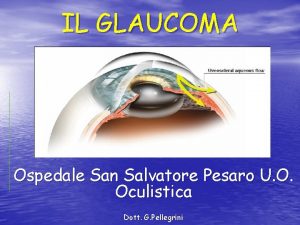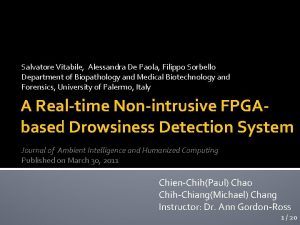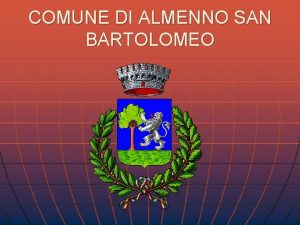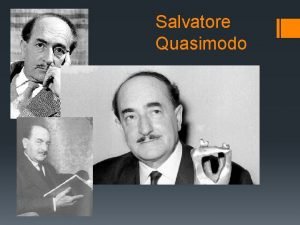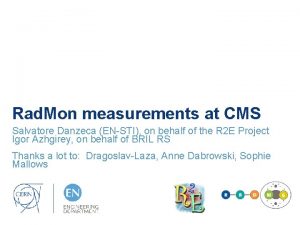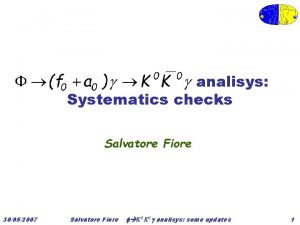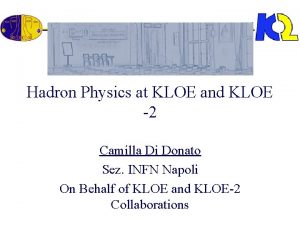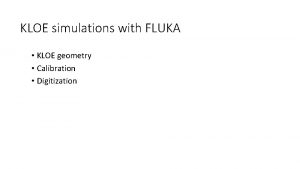CPCPT tests at KLOE Salvatore Fiore University of













- Slides: 13

CP/CPT tests at KLOE Salvatore Fiore University of Rome La Sapienza & INFN Roma 1 for the KLOE collaboration LNF Spring School “Bruno Touscheck”, Frascati, 15 -19 May 2006

Neutral kaons at a f-factory • e+e f sf~3 mb S = mf = 1019. 4 Me. V • BR(f K 0 K 0) ~ 34% • ~106 neutral kaon pairs per pb-1 produced in an antisymmetric quantum state with JPC = 1 K +K - K LK S 1. 5 106 /pb-1 p* = 127 Me. V/c l±= 95 cm 106 /pb-1 ; p* = 110 Me. V/c l. S = 6 mm KS decays near interaction point l. L = 3. 4 m Large detector to keep reasonable acceptance for KLdecays (~0. 3 l. L) 2

Neutral kaons at a f-factory: tagging The f decay at rest provides monochromatic and pure beam of kaons Tagging: observation of KS, L signals presence of KL, S - precision measurement of absolute BR’s p. K = 110 Me. V/c l. S = 6 mm l. L = 3. 5 m f 1 t 1 KS, L f Dt=t 1 - t 2 KL, S f 2 The detection of a kaon at large (small) times tags a KS (KL) possibility to select a pure KS beam (unique at a ffactory, not possible at fixed target experiments) 3

DAFNE: the Frascati f-factory W = m. F (1019. 4 Me. V) Ldesign 5 1032 cm-2 s-1 2001 170 pb-1 2002 280 pb-1 2004 734 pb-1 2005 1256 pb-1 Data taking finished last March • Lpeak= 1. 3 × 1032 cm 2 s 1 • Ltot 2. 5 fb-1 4

KLOE experiment The KLOE design was driven by the measurement of direct CP through the double ratio: R = G(KL p+p ) G(KS p 0 p 0) / G(KS p+p ) G(KL p 0 p 0) Be beam pipe (spherical, 10 cm , 0. 5 mm thick) + instrumented permanent magnet quadrupoles (32 PMT’s) • Drift chamber (4 m 3. 75 m, CF frame) Gas mixture: 90% He + 10% C 4 H 10 12582 stereo sense wires almost squared cells Electromagnetic calorimeter lead/scintillating fibers (1 mm ), 15 X 0 4880 PMT’s 98% solid angle coverage • Superconducting coil (B = 0. 52 T) 5

KLOE detector specifications sp/p = 0. 4 % (tracks with q > 45°) sxhit = 150 mm (xy), 2 mm (z) sxvertex ~1 mm s(Mpp) ~1 Me. V s. E/E = 5. 7% / E(Ge. V) st = 54 ps / E(Ge. V) 50 ps svtx(gg) ~ 1. 5 cm (p 0 from KL p+p p 0) 6

KS and KL tagging KL “crash” b= 0. 22 (TOF) K S p +p K S p -e +n KS tagged by KL interaction in Em. C Efficiency ~ 30% (largely geometrical) KS angular resolution: ~ 1° (0. 3 in f) KS momentum resolution: ~ 2 Me. V KL 2 p 0 KL tagged by KS p+p- vertex at IP Efficiency ~ 70% (mainly geometrical) KL angular resolution: ~ 1° KL momentum resolution: ~ 2 Me. V 7

BR KL p+ p : CP Violation CP violating decay Related to K using KL beam tagged by KS → p+p 328 pb-1 ’ 01+’ 02 data Selection • KL vertex reconstructed in DC • PID using decays kinematics • Fit with MC spectra including radiative processes Normalization using KL pmn events in the same data set 8

Preliminary result BR(KL p+p )= (1. 963 0. 012 0. 017) 10 -3 • in agreement with KTe. V [PRD 70 (2004), 092006] BR=(1. 975 0. 012) 10 3 • confirm the discrepancy (4 standard deviations) with PDG 04 BR=(2. 090 0. 025) 10 3 BR(KL p+p ) 10 -3 BR KL p+ p : CP Violation (II) PDG 2004 KTe. V KLOE preliminary Using BR(KS pp) and t. L from KLOE and t. S from PDG 04 | | = (2. 216 0. 013) 10 -3 | | PDG 04 = (2. 280 0. 013) 10 -3 1. 5 s with respect to prediction from Unitarity Triangle 9

CPT test: the Bell-Steinberger relation Exact relation: phase convention independent, no approx, in the CPT limit Looking at Im(D) 0 as CPTV signal Measurements of KS KL observables can be used for these tests: a+ = h+ B(KS p+p ) a 00= h 00 B(KS p 0 p 0) a+ g= h+ B(KS p+p g) akl 3 = 2 t. S/t. L B(KLl 3) [Re Re y i( Im d + Im x+)] = 2 t. S/t. L B(KLl 3)[(AS+AL)/4 i( Im d + Im x+)] a+ 0= t. S/t. L h+ 0* B(KL p+p p 0) a 000= t. S/t. L h 000* B(KL p 0 p 0 p 0) 10

CPT test: inputs to the Bell-Steinberger relation B(KS p+p )/B(KS p 0 p 0)=2. 2549 0. 0059 B(KS p+p g)<9 10 5 t. S= 0. 08958 ± 0. 00006 ns B(KL p+p g)=(29 1) 10 6 t. L= 50. 84 ± 0. 23 ns B(KL pln)=0. 6705 0. 0022 3 + 0 7 A =(3. 32 0. 06) 10 B(KS p p p )=(3. 2 1. 2) 10 L 3 + 0 A =(1. 5 10. 0) 10 B(KL p p p )=0. 1263 0. 0012 S B(KL p+p )=(1. 963 0. 021 ) 10 3 B(KS p 0 p 0 p 0)<1. 2 10 7 B(KL p 0 p 0)=(8. 65 0. 10) 10 4 f. SW = (0. 759± 0. 001) + =0. 757 ± 0. 012 000 + g f f , f =[0, 2 p] f 00 = 0. 763 ± 0. 014 Im x+ = (0. 8 ± 0. 7) 10 -2 Im x+ from a combined fit of KLOE + CPLEAR data 11

CPT test: accuracy on ai We get the following results (error contours) on each term of the sum 10 -4 a+ = h+ B(KS p+p ) a 00= h 00 B(KS p 0 p 0) a+ g= h+ B(KS p+p g) 2 t. S/t. L B(KLl 3) [ (AS+AL)/4 i Im x+] Im Re a+ 0= t. S/t. L h+ 0*B(KL p+p p 0) a 000= t. S/t. L h 000*B(KL p 0 p 0 p 0) 12

CPT test: B-S KLOE result Im Re KLOE preliminary: Re = (160. 2 1. 3) 10 -5 Im =(1. 2 1. 9) 10 -5 CPLEAR: Re = (164. 9 2. 5) 10 5 Im =(2. 4 5. 0) 10 5 13
 Cqc kloes poster
Cqc kloes poster Ace different iq tests still make
Ace different iq tests still make Ospedale s salvatore pesaro
Ospedale s salvatore pesaro Oggi è nato per noi il salvatore salmo
Oggi è nato per noi il salvatore salmo Salvatore vitabile
Salvatore vitabile Salvatore guarnieri
Salvatore guarnieri Pgt almenno san salvatore
Pgt almenno san salvatore Salvatore spinello
Salvatore spinello Profit management in managerial economics
Profit management in managerial economics Salvatore fazio
Salvatore fazio Salvatore davide porzio
Salvatore davide porzio Biografia quasimodo
Biografia quasimodo Salvatore danzeca
Salvatore danzeca Salvatore de masi
Salvatore de masi


